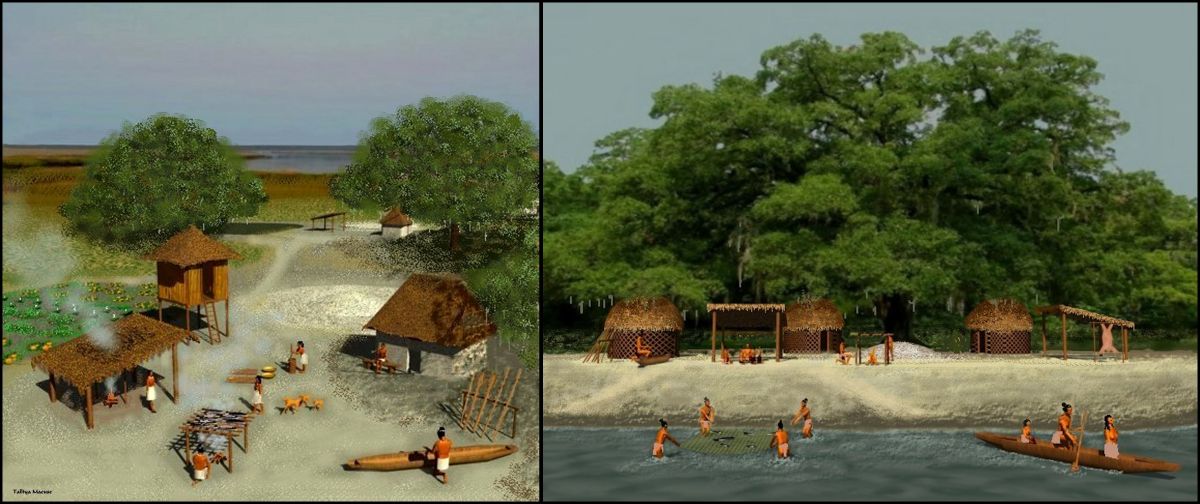by Richard L. Thornton, Architect & City Planner
Pick up an anthropology textbook from the late 20th century and it will tell you that prior to the arrival of Europeans, the South Atlantic Coast was occupied by Siouans, Cusabos, Creeks and Timucuans. Of these four, only the Cusabos called themselves by that name . . . and it was the name of an alliance, meaning . . . “strong – place of” in the Panoan language of Peru!
During my journeys through a stack of 18 dictionaries, I found something very interesting. There was a branch of the Taino People in Cuba, named the Yamasa. That is terribly close to the name of a tribe in the southern tip South Carolina and southeastern Georgia, named the Yamasee. Yama is the name of a Taino and Carib deity. Yamacora (Yamacraw in 18th century English) also means Yama People. In other words, the part of Georgia below the Fall Line was originally occupied mainly by people from the Caribbean Basin and South America.
Armed with a stack of new dictionaries, I was able to translate surviving “Native American” place names from the North-South Carolina line down to the tip of Florida. There were a lot of surprises. It seems that the first History of the State of Georgia (1843) by Dr. William Bacon Stevens was far more accurate ethnologically than modern texts.
Stevens book opens up by stating that early settlers on the South Carolina and Georgia coast encountered light skinned Indians, who spoke a dialect of Gaelic, which Irish immigrants could understand. They were the Duhare (Du H’Aire) or Early Medieval Irish colonists. Stevens said that the Norsemen from Dublin and Wexford, who ferried the Irish over in their Scandinavian ocean-going boats, settled to the north of the Irish in South Carolina. Indeed, that is what I found. He also said that peoples from the Caribbean Basin settled to the south of them. Indeed, that is what I found.
Many of the Irish place names were “no brainers.” Kialege (written Kiare-ge) is what the people of County Kerry are called today. It is also a Creek tribal town in Oklahoma. Many place names were the same in both Georgia and locations “South of the Border.” For example, there was a Satipo Province in Peru and Satipo Province in Southeast Georgia. Both were ruled by a Sati-uriwa (king). There were orata (village chiefs) all over the place in South Carolina and Peru. There were heneha’s all over the place in the Maya lands and Georgia. Guadaquini was the indigenous name for Jekyll Island, GA. That’s the Taino word for a circular ceremonial space for dancing and feasting.
Going from north to south, here is a list of the ethnic groups that I was able to identify:
- Siouan with some Irish words
- Santee – Panoan from Peru
- Winyah Bay Estuary – Early Medieval Norse
- Charleston Bay – Muskogee-Creek tribal names
- Cusabo – Panoan from Peru
- Itsate-Creek tribal names
- Port Royal Sound – Carib tribes from Venezuela
- Uchee Water and Raccoon Clans
- Kiawah and Daufuskee Islands – Early Medieval Irish Gaelic
- Savannah – Apalachicora from Peru, plus Uchee
- Savannah – Yamacora from Cuba
- Tybee Island – Itza or Chontal Maya salt traders
- Osabaw Island – Panoan from Peru
- Ogeechee River – Duhare and Uchee
- Wassaw Island – Polynesian with Maori DNA markers ???
- Sunbury Sound – Carib from Venezuela
- Canoochee River and Blackbeard Island – Tupi from South America
- St. Catherines Island – Taino from Antilles
- St. Simons Island – Southern Arawak and Taino
- Jekyll Island – Taino from Antilles
- Sapelo Island – Tupi from NE South America & Panoans from Peru
- Alekmanni – Anglisk from Scandinavia (Yes! Really!)
- Satilla River – Satile (Panoans) from Peru
- Cumberland and St. Mary’s Sound – Mocama from Venezuela
- NE Florida – Wareo from Venezuela
- East Central Florida – Ciboney from Cuba
- SE Florida – Tequista – Tequis Caribs from Venezuela
- SW Florida – Tequista – Tekesta Caribs from Veracruz


https://www.bing.com/videos/search?q=grand+canyon+city&ru=%2fvideos%2fsearch%3fq%3dgrand%2bcanyon%2bcity%26FORM%3dHDRSC3&view=detail&mid=5C3C5DB231252DF2CA5D5C3C5DB231252DF2CA5D&&FORM=VDRVRV
Richard, Perhaps more connections than we were taught? The “Para” sound is a connection to the people of the Middle East, Egypt, India, Georgia… and a lost ancient civilization that extended to Arizona. I have to wonder what was found in those under ground cities of Egypt and Arizona that has been kept a Euro / U.S. Secret. Perhaps you are closing in too another more ancient under ground city in the South East?
LikeLiked by 1 person
As always, a really fascinating take on the history of the world and area. Just reinforces for me how the average American like myself reared up in public schools of the late 20th century, only given parables and splinters of historical events. It took moving to Georgia as a young art student, reading books like Oglethorpe In Perspective by ole’ Phinizy Spalding or The Land of Allyon, mixed with other research at The Georgia Historical Society and my own intuitions, that I began to understand other histories (and motives for them) well outside the narrative of my programming had been going on, and their signs (and symbols) all around me. Sitting here I cannot think of the website, which is saved on an older laptop, that shows all of the Indian villages of Georgia & South Carolina in the 1600s through 1800s and when one looks at them from the perspective of current State lines, you realize how much of a network of people and trade actually existed. Although the internet came later in my education, I still think to myself how sad it is that the average American or perhaps even middle schooler lacks this perspective. All the same, keep up the great work and look forward to more of your posts and will share with others!
LikeLiked by 1 person
Brilliant as usual, thank you!
LikeLiked by 1 person